Oracle Statistics By Employee, Revenue And Facts (2025)
Updated · Sep 24, 2025
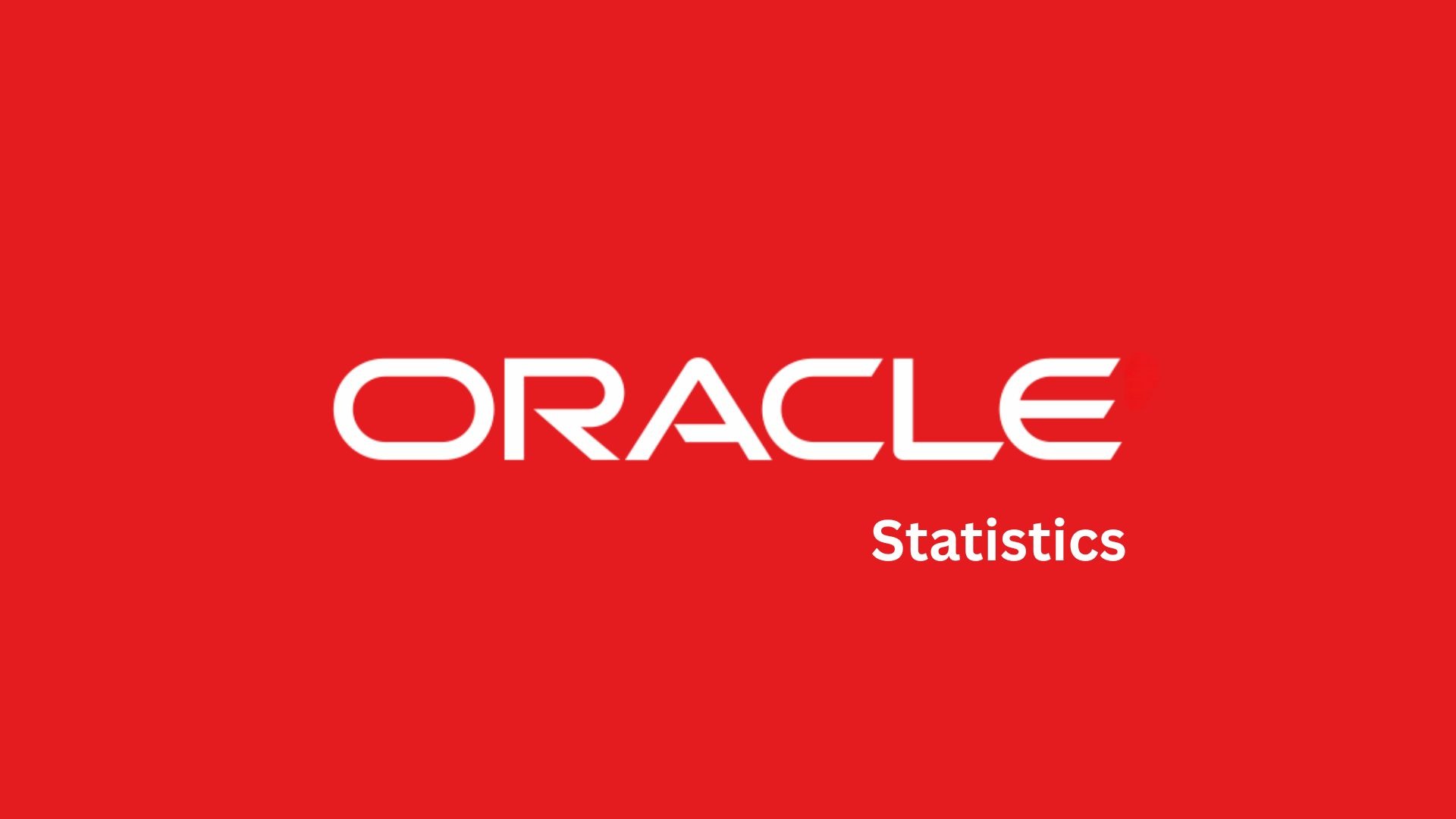
Table of Contents
- Introduction
- Editor’s Choice
- General Facts
- Oracle Stock Surge (10th Sept 2025)
- Oracle’s Revenue By Business Segment
- Oracle Income Statement
- Oracle Research And Development Spending
- Oracle Revenue By Region
- Oracle Stock Price Prediction 2024
- Oracle Stock Prediction – Market Sentiment
- Oracle Employees Statistics
- Oracle Future Product Release
- Recent Developments
- Conclusion
Introduction
Oracle Statistics: Oracle Corporation, one of the few remaining global enterprise software and cloud computing powerhouses, has testified to tremendous growth and innovation in 2024. With cloud infrastructure and AI as key focus areas, Oracle has become a dauntless contender in the game of technological evolution.
This article carries Oracle statistics, performance, market share, technological advancements, and future outlook through a detailed statistical analysis of its operations in 2024.
Editor’s Choice
- Cloud revenue for Oracle doubled from US$4.4 billion in Q4 FY2023 to US$5.3 billion in Q4 FY2024, representing a 20% increase.
- Infrastructure-as-a-Service skyrocketed 42% to US$2.0 billion, while cloud applications were up 10% to US$3.3 billion.
- Fusion Cloud ERP grew 14% to US$0.8 billion, and NetSuite Cloud ERP was up 19% to US$0.8 billion.
- In Q4, GAAP EPS was US$1.11, while non-GAAP EPS was US$1.63.
- Operating income stood at US$4.7 billion GAAP and US$6.7 billion non-GAAP, with operating margin percentages of 33 (GAAP) and 47 (non-GAAP).
- For full fiscal 2024, Oracle reported GAAP EPS coming in at US$3.71 and non-GAAP EPS at US$5.56.
- Services associated with the cloud and license-support revenues witnessed a 12% YoY growth to US$39.4 billion, whereas revenues from cloud license and on-premise licenses witnessed a 12% drop to US$5.1 billion.
- In 2024, Oracle generated revenues of US$33.1 billion from the Americas, US$13.0 billion from EMEA, and US$6.8 billion from Asia Pacific, showing a growing trend across all regions.
- Oracle is currently trading at US$123.88, and analysts predict an average price target of US$140, with highs of US$160 and lows of US$105.
- Market sentiment appears bullish: 56% of the analysts rate the stock as “Buy,” while 44% say “Hold,” with no ratings in the “Sell” zone.
- Institutional investors are believed to possess roughly 43.44% of Oracle shares, nearly US$148 billion in worth, demonstrating institutional confidence.
- With about 159,000 employees in 2024, Oracle had more than twice the number of people the company had in 2008, which was 74,670.
General Facts
- In 1977, with only US$2,000 in capitalization, Larry Ellison, Bob Miner, and Ed Oates founded a software company called Software Development Laboratories at its inception in Santa Clara, California.
- In 1982, the company changed its name to Oracle Systems Corporation, which changed again in 1995 to Oracle Corporation.
- The company was on a mission to equip mankind with a powerful yet simple-to-use database management system, while modernising and simplifying data management.
- The first commercial software, Oracle Version 2, was an RDBMS shipped in 1979.
- By 1987, Oracle was at version 5.1; with such maturity came the decision to go public: Oracle would become a global business, making over US$500 million in revenues by the late 1980s.
- Annual revenues for Oracle in fiscal 2023 approached the US$50 billion milestone, with net income going over US$8 billion.
- The most recent iteration of the RDBMS, Oracle 23ai, was launched in May 2024 with an infusion of AI-powered capabilities into the database.
- Cloud and licenses are the biggest revenue source for Oracle, which was around US$35 billion in 2023.
- With the acquisition of Sun Microsystems in 2010, Oracle had gotten itself into hardware, engineered systems, servers, and storage.
- Through Oracle Academy, Oracle partners with governments and educational institutions to provide training in technology and computing skills.
- The company was on a top 20 most valuable brands list, having a brand value of nearly US$90 billion.
- It is also ranked among the top 100 largest companies in the world in terms of its market value.
- In 2023, Larry Ellison was behind Steve Ballmer and Bill Gates in the United States as they stood ranked third, but fourth on a global scale, with an approximate net worth of around US$137 billion.
Oracle Stock Surge (10th Sept 2025)
- Stock Price Surge: Oracle’s stock gained 36%, marking its best day since 1992, adding $244 billion in market value.
- Cloud Demand: The company reported outstanding cloud demand numbers, positioning itself on track for the $1 trillion market cap milestone.
- Remaining Performance Obligations: Oracle has $455 billion in remaining performance obligations, a 359% increase from the previous year.
- Larry Ellison’s Net Worth: Oracle’s founder, Larry Ellison, added $100 billion to his net worth, surpassing Elon Musk to become the world’s richest person.
- Cloud Infrastructure Revenue Forecast: For fiscal 2026, Oracle projects $18 billion in cloud infrastructure revenue, expecting growth to $32 billion in 2027, $73 billion in 2028, $114 billion in 2029, and $144 billion by 2030.
- Quarterly Earnings: Oracle reported $1.47 per share in adjusted earnings for the quarter, slightly below the $1.48 per share analysts expected.
- Quarterly Revenue: Revenue for the first quarter stood at $14.93 billion, missing analysts’ expectations of $15.04 billion.
Oracle’s Revenue By Business Segment
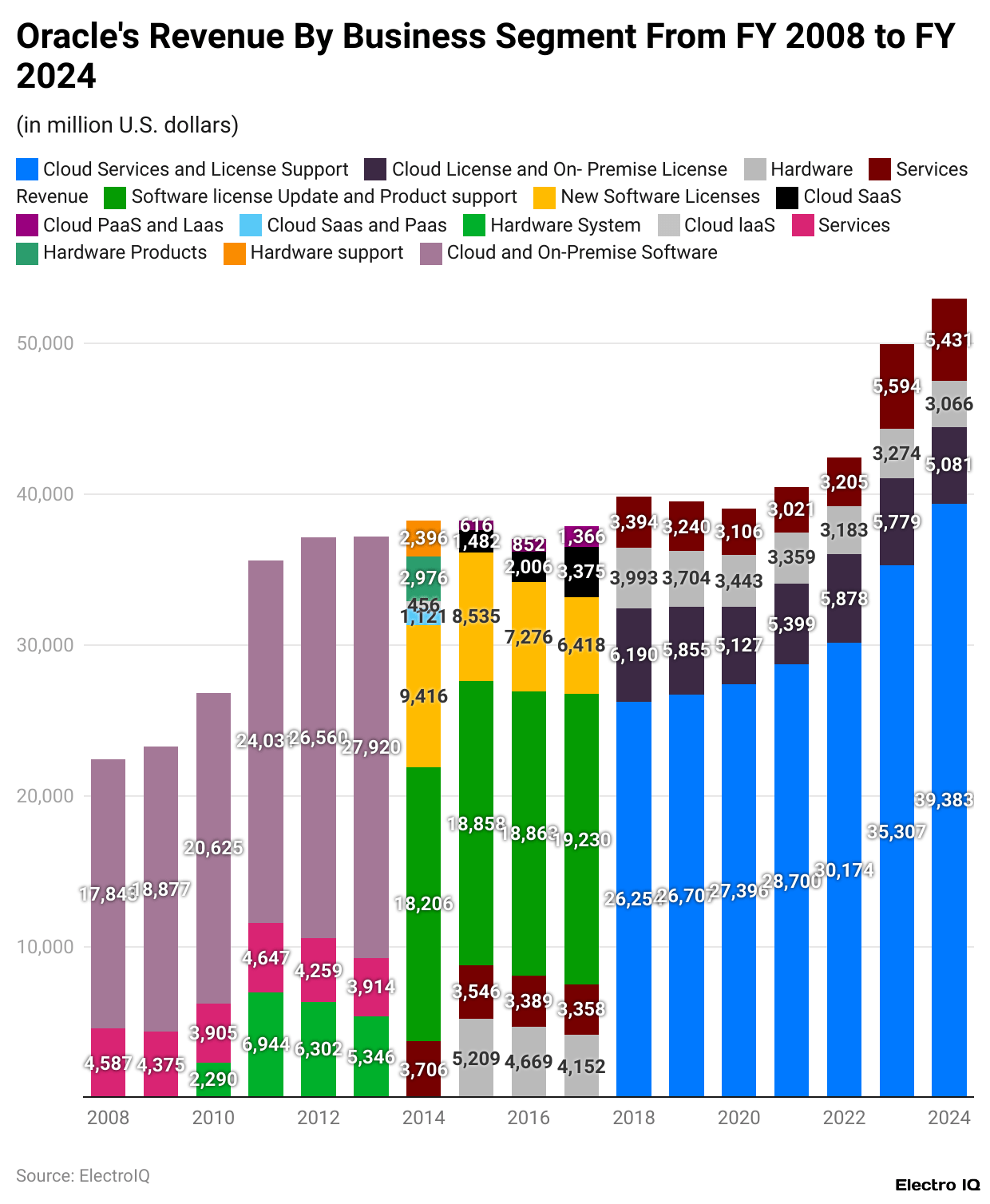
(Reference: sci-tech-today.com)
- As per a Statista report, Oracle statistics state that in fiscal 2024, the cloud services and license support segment was most productive for Oracle with revenues of USD 39,383 million.
- Cloud license and on-premise license revenues trailed behind, clocking USD 5,081 million, followed by hardware at USD 3,066 million, and services at USD 5,431 million.
- The trend, on the other hand, has been quite telling in the years past, with the cloud services.
- License support is growing to nearly USD 40 billion in 2024 from USD 27,396 million in 2020, all of which is indicative of the cloud’s growing importance to Oracle’s business model.
- Contrariwise, cloud license and on-premise license revenues have been dwindling rather gradually, from USD 5,127 million in 2020 down to USD 5,081 million in 2024, showing that the moves have all been away from the traditional licensing model.
- Notice also that with the passing years, hardware revenue steadily declined, decreasing slightly from USD 3,443 million in 2020 to USD 3,066 million in 2024.
- Service revenue has shown some ups and downs; it dropped to USD 3,021 million in 2021 and bounced back in 2024 to USD 5,431 million.
- Generally, this data indicates how much Oracle is gearing toward cloud services in revenue enhancement, while more traditional sectors such as hardware and on-premise licensing continue to diminish.
Oracle Income Statement
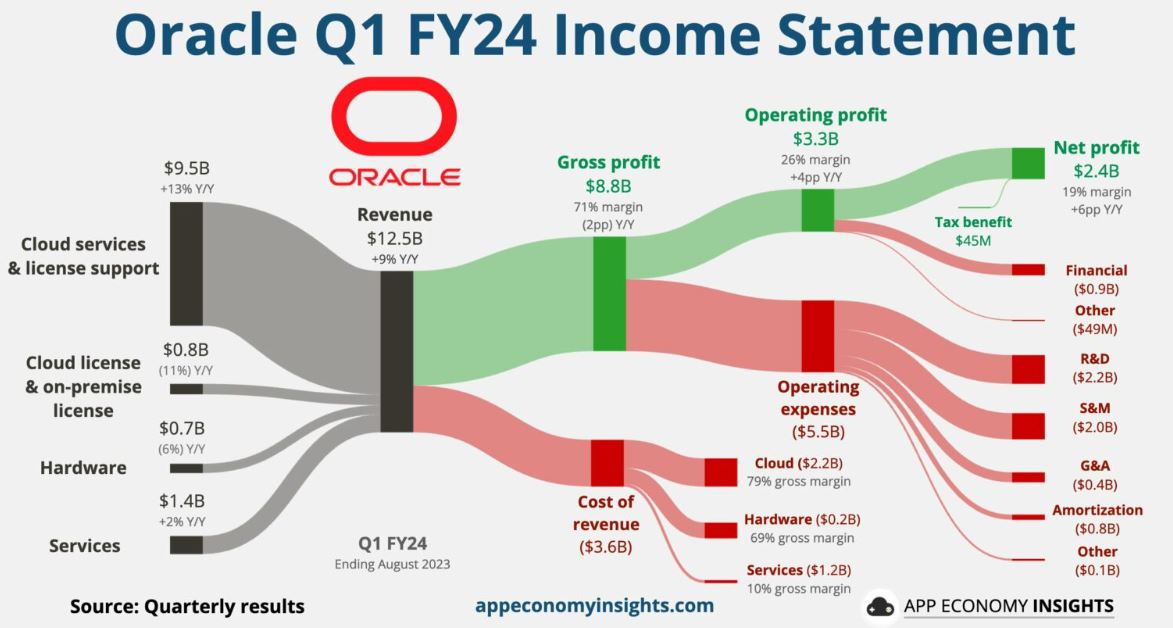
(Source: futurumgroup.com)
- The Oracle cloud business presents a picture with positives and negatives as it ended the fourth quarter of fiscal year 2024.
- The company reported US$5.3 billion in total cloud revenues, comprising Infrastructure-as-a-Service (IaaS) and Software-as-a-Service (SaaS), which is a 20% increase from the previous year.
- It was cloud infrastructure revenues that derived IaaS money, strong in demand for Oracle, standing at US$2.0 billion with a great 42% rise year-over-year.
- Cloud applications income stood at US$3.3 billion, up 10%, with Fusion Cloud ERP at US$0.8 billion, up 14%.
- NetSuite Cloud ERP at US$0.8 billion, up 19%.growth while traditional segments such as hardware and on-premise licensing continue to decline.
- While cloud revenues grew at a weak 20% rate compared to earlier periods, IaaS revenues enjoyed very strong momentum.
- Also, investor confidence was boosted by the recently announced partnership between Oracle and OpenAI, similar to the upbeat market reaction when Apple disclosed its collaboration with OpenAI.
- Oracle reported fourth-quarter earnings per share of US$1.11 on a GAAP basis and US$1.63 on a non-GAAP basis.
- Operating income for the quarter was US$4.7 billion on a GAAP basis and US$6.7 billion on a non-GAAP basis, an increase of 8%.
- The company also improved its operating margin, with GAAP operating margin at 33% and non-GAAP operating margin at 47%.
- The company posted earnings of US$3.71 per share on a GAAP basis and US$5.56 per share on a non-GAAP basis during the fiscal year.
- Looking at streams of revenue, cloud services and license support grew 9% in Q4, to US$10.2 billion, while cloud license and on-premise license revenues fell 15%, to US$1.8 billion.
- For the whole year, strong growth in recurring cloud subscriptions has been reflected in cloud services and license support revenues going up 12% to US$39.4 billion.
- The cloud license and on-premise license revenues have fallen 12% to US$5.1 billion, showing the continued shift from traditional licensing toward cloud-based services.
Oracle Research And Development Spending
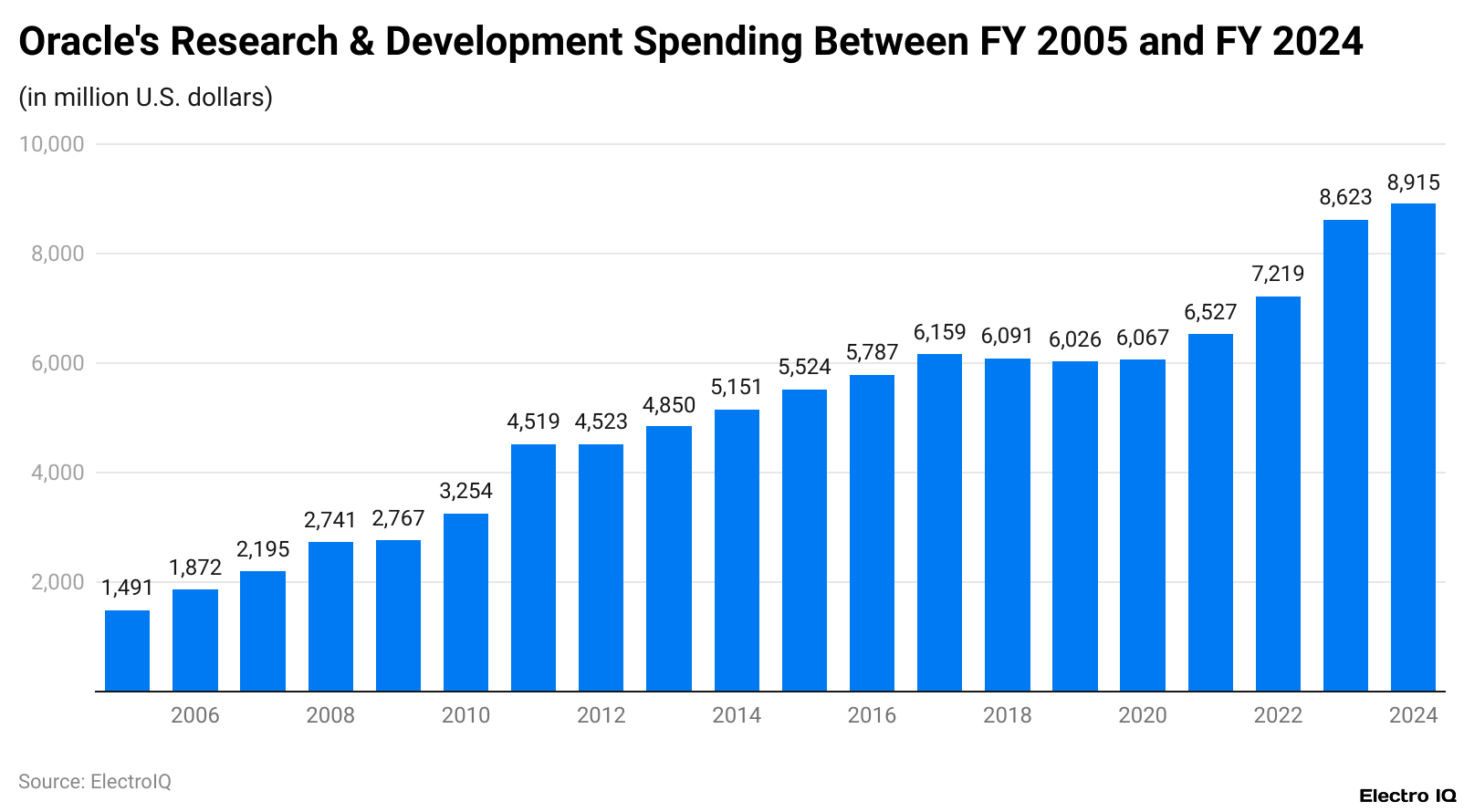
(Reference: sci-tech-today.com)
- The content highlights shifts over time in Oracle revenues.
- In the year 2024, the bulk of Oracle revenue was charged through cloud services and license support, which therefore indicates a strong bent toward cloud-based solutions.
- Until 2017, software license updates and product support revenues were the top contributors, which means traditional software maintenance and licensing revenues were more dominant before.
- Similarly, PaaS and IaaS had been, until 2013, the main streams contributing to Oracle’s significant revenues, connotating the formative years of its cloud offerings before cloud services took the forefront of revenues.
- Demonstrating an intermediate movement over the years, the latter has slowly taken precedence over traditional software support.
Oracle Revenue By Region
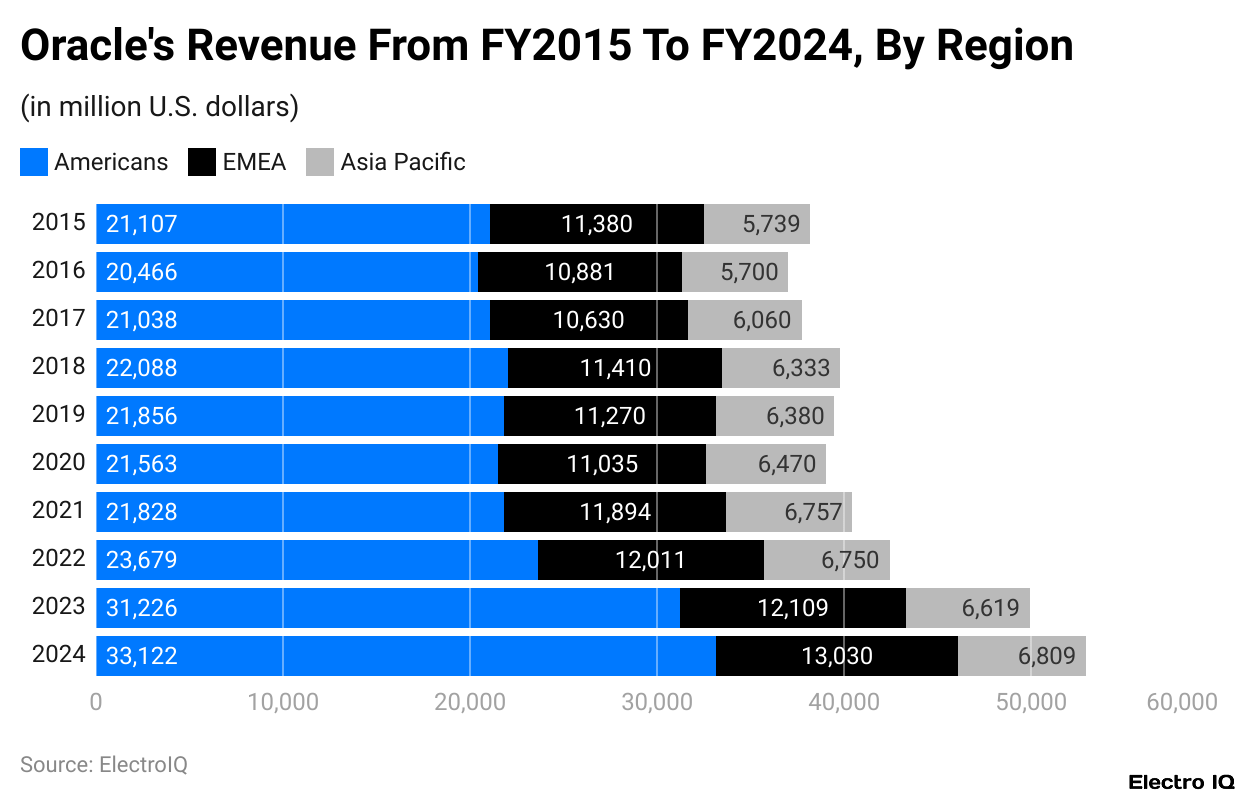
(Reference: coolest-gadgets.com)
- Oracle’s revenue exhibited growth in all its major territories in 2024. About USD 33,122 million came in from the Americas, which remained the biggest market.
- The EMEA region (Europe, the Middle East, and Africa) contributed around USD 13,030 million, while the Asia Pacific region brought in approximately USD 6,809 million.
- All regions experienced a surge when stacked against 2023 numbers-the Americas rose from USD 31,226 million, EMEA from USD 12,109 million, and Asia Pacific from USD 6,619 million.
- This shows consistent growth, year on year, in all global markets for Oracle, with the Americas still accounting for the bulk of the revenue.
Oracle Stock Price Prediction 2024
- The shares of Oracle are currently trading at US$123.88, while analysts expect an average price target of US$140 by the end of 2024.
- Based on technical indicators, mainly Fibonacci levels of retracement and extension, steady momentum in the upward direction is expected.
- On the upbeat side, the share price could attain US$164, with the share price set low as US$87 on the sharp downward move-pessimistic view.
- In this current turning, the stock is undergoing sideways movement at the trendline of US$118.08 and a baseline of US$117.67.
- These levels are because they are averages of modified exponential moving averages, showing low volatility and stable movement. US$121 constitutes a zone of support, while the corresponding pivot lies at US$113.70.
- The resistance gets fixed at US$140, with the average forecast in alignment. US$87.21 stands under deeper support, describing the lower-bound prediction.
- The technical signals further corroborate the stability of the stock.
- The RSI (Relative Strength Index) stands at 57.05, revealing a neutral market stance with no evidence of overbought or oversold conditions.
- The MACD (Moving Average Convergence Divergence) points toward bullishness, with the MACD line (2.58) above the signal line (2.36) and the value of its histogram remaining at 0.220, indicating sustained but moderate upward momentum.
- The PVT (Price Volume Trend) line currently sits at 2.594 billion, which is above the 2.591 billion moving average, indicating that volume is confirming the price growth.
- In combination, all of these signals point out that the Oracle stock is carrying stable performances, with the support of investor activities for moderate bullish momentum.
Oracle Stock Prediction – Market Sentiment
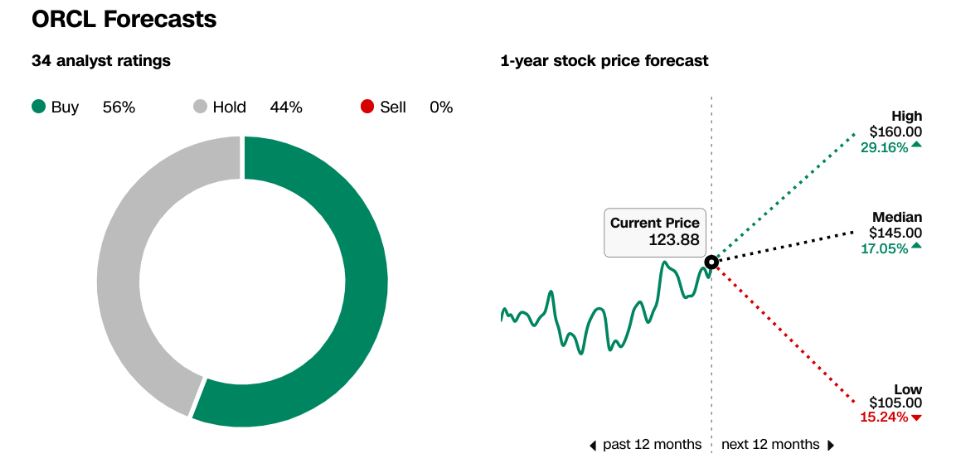
(Source: vstar.com)
- Analyst sentiment around Oracle’s stock is largely positive. According to CNN.com, out of 34 analysts, 56% recommend it as a “Buy” and 44% as a “Hold,” with no “Sell” ratings at all.
- On the other hand, their one-year price targets forecast possibilities of an upside, with the highest estimate at US$160.00, about 29% above the current price of US$123.88.
- The median target stands at US$145.00, which itself translates to some 17% upside, while the lowest estimate is US$105.00, putting it at about 15% downside.
- The Wall Street Journal shares rather similar findings that the last couple of months have remained steady concerning analyst recommendations: 16 have rated Oracle a “Buy”; three have “Overweight” ratings, and 15 rated “Hold,” again with no “Sell” ratings allowed.
- Targets also mirror fairly closely those cited by CNN: a high of US$160, a median of US$145, and a low of US$105.
- The average target is US$139.91, which implies that most of the analysts foresee the share price of Oracle to rise from its current level.
- Institutional investors also show great confidence in Oracle, as they currently hold almost 43.44% of the equity of the company, valued at close to US$147.9 billion.
- Heavy institutional ownership usually signals the belief in the long-term existence of a company.
- The short interest in Oracle stands at 15.4 million shares, or 0.96% of shares outstanding, with a days-to-cover ratio of 2.48.
- Short interest, being relatively low, reveals an absence of bearish sentiment. This fact supports the stock’s positive outlook.
Oracle Employees Statistics
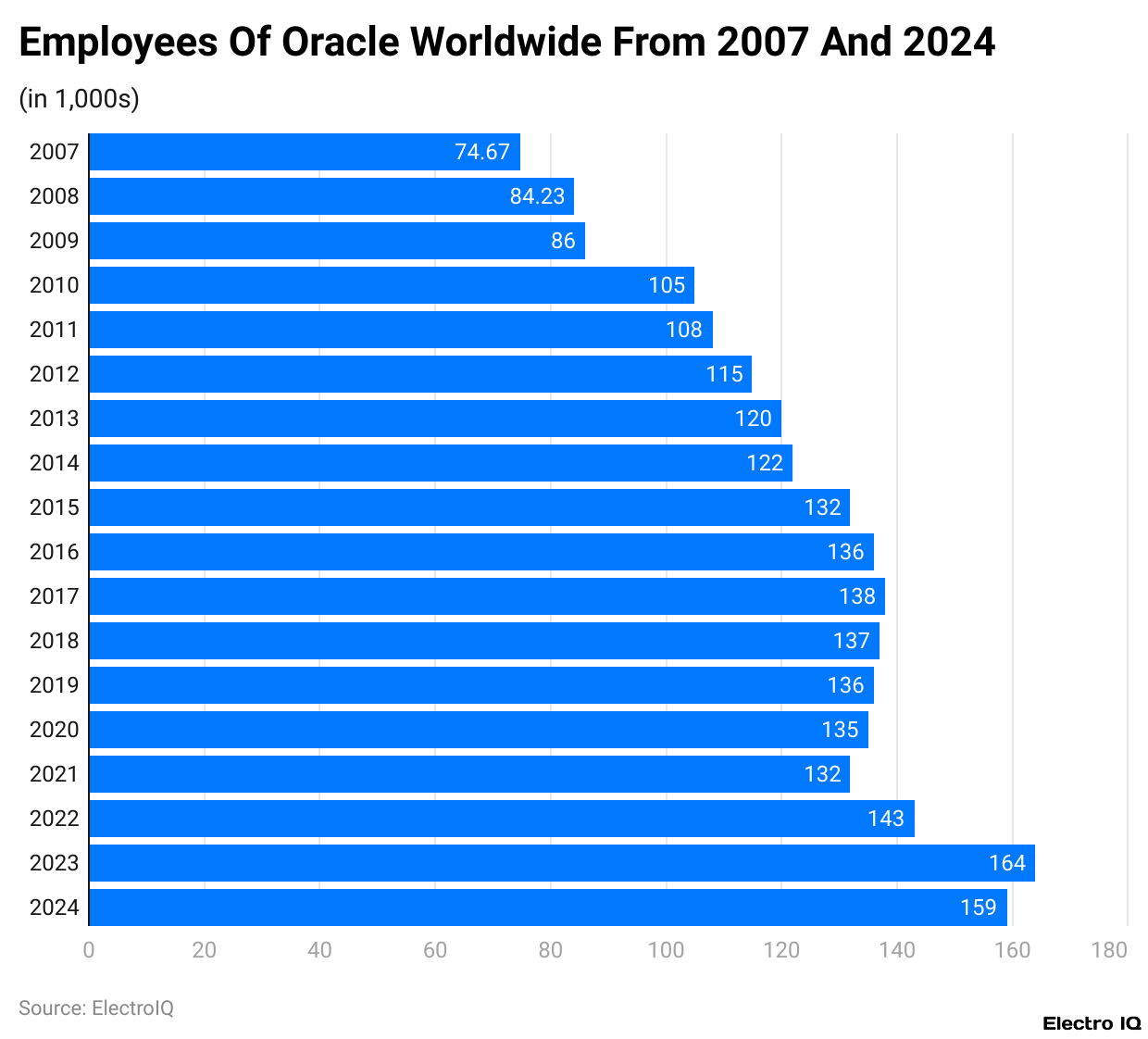
(Reference: sci-tech-today.com)
- As per Statista, Oracle statistics show that Oracle, as a company, has undergone a considerable growth change in its workforce over the years.
- Back in the year 2008, it employed about 74,670 people, and the number has gone up to almost 159,000 employees worldwide in 2024.
- The most recent years depict: 164,000 in 2023, 143,000 in 2022, and 132,000 in 2021. The earlier numbers show 135,000 in 2020, 136,000 in 2019, 137,000 in 2018, 138,000 in 2017, 136,000 in 2016, and 132,000 in 2015.
- These numbers convey that Oracle has steadily grown its workforce, indicating its cloud services, global presence, and heavy investment in technology infrastructure.
Oracle Future Product Release
- In 2024, Oracle will be focused predominantly on expansion and enhancements to its product and services offerings, mainly in the cloud and AI space.
- New data centre locations throughout the globe will bolster the Oracle Cloud Infrastructure (OCI) platform to further support the cloud-native applications and large enterprise workloads.
- The Oracle Autonomous Database is also being upgraded with more advanced artificial intelligence features, enabling real-time data analytics, improved machine learning capabilities, and stronger data security.
- Additionally, Oracle’s ERP Cloud will see new enhancements, including modules designed to improve financial planning and optimise supply chain management.
- These updates reflect Oracle’s strategy to provide more integrated and intelligent cloud solutions for businesses.
Recent Developments
- Oracle has been driving much of its recent growth through product development and innovation, with a strong focus on cloud and database technologies.
- Its Oracle Cloud Infrastructure (OCI) has played a key role, with 2023 bringing new services such as advanced machine learning features and improved security.
- These updates attracted a wide range of customers, from smaller businesses to large global enterprises.
- Looking ahead to 2024, Oracle is planning to expand OCI further by adding new regional data centres and enhancing multi-cloud capabilities, moves that are expected to boost customer adoption and bring in more revenue from cloud services.
- The Oracle Autonomous Database is still among the most important offerings from the house of Oracle.
- In 2023, Oracle made available new automation processes that lessen administrative work requirements while enhancing database performance, thereby attracting companies that want operational simplification.
- For 2024, the intent is to augment its capabilities with deeper artificial intelligence and machine learning integration, so that customers gain insight into their data to make better business decisions.
Conclusion
Performance for 2024 thus points to Oracle’s strategic thrust into cloud computing and artificial intelligence. Oracle, equipped with strong financial results, good market share in the database space, and aggressive investments in cloud infrastructure, is all set for continued growth. To complement this, the company also puts forth future-oriented initiatives, further cementing its role in innovation and being at the forefront of the technology industry.
Sources
FAQ.
Q4FY2024 rolls out with Oracle’s total cloud revenue, in which IaaS and SaaS contribute, touching US$5.3 billion, a 20% y-o-y increase. IaaS saw a big spur, with revenue growing 42% to US$2 billion, while Cloud Applications brought home US$3.3 billion, up 10%. Fusion Cloud ERP and NetSuite Cloud ERP provided US$0.8 billion revenue each and witnessed growth of 14% and 19%, respectively.
Oracle’s main revenue source remains cloud services and license support, garnering almost US$39.4 billion in 2024. Cloud license and on-premise license revenue declined marginally to US$5.1 billion. Hardware revenue dipped to US$3.1 billion, while services revenue saw a rebound to US$5.4 billion.
In 2024, Oracle registered revenues of US$33.1 billion from the Americas, US$13.0 billion from the EMEA region, and US$6.8 billion from the Asia Pacific. With all three regional segments showing growth as compared to 2023, the Americas kept being the largest contributor, showing consistent expansion on the global plane with an association defined well across all major regional areas.
With a current price of US$123.88, the stock is projected by analysts to reach an average target price of US$140 by the end of 2024, with a high of US$160 and a low of US$105. Market sentiment is in favour of the company, as 56% of all analysts recommend a “Buy” and 44% a “Hold,” with none declaring a “Sell.” Institutional investors hold 43.44% of the shares worth US$148 billion, which strengthens the longer term confidence in Oracle’s performance.
Oracle’s Oracle Cloud Infrastructure (OCI) is enhanced with new global data centres as well as multi-cloud capabilities. Furthermore, new enhancements are developed with the Oracle Autonomous Database to bring AI and machine learning into the fold for real-time analytics and enhanced security.

I hold an MBA in Finance and Marketing, bringing a unique blend of business acumen and creative communication skills. With experience as a content in crafting statistical and research-backed content across multiple domains, including education, technology, product reviews, and company website analytics, I specialize in producing engaging, informative, and SEO-optimized content tailored to diverse audiences. My work bridges technical accuracy with compelling storytelling, helping brands educate, inform, and connect with their target markets.










